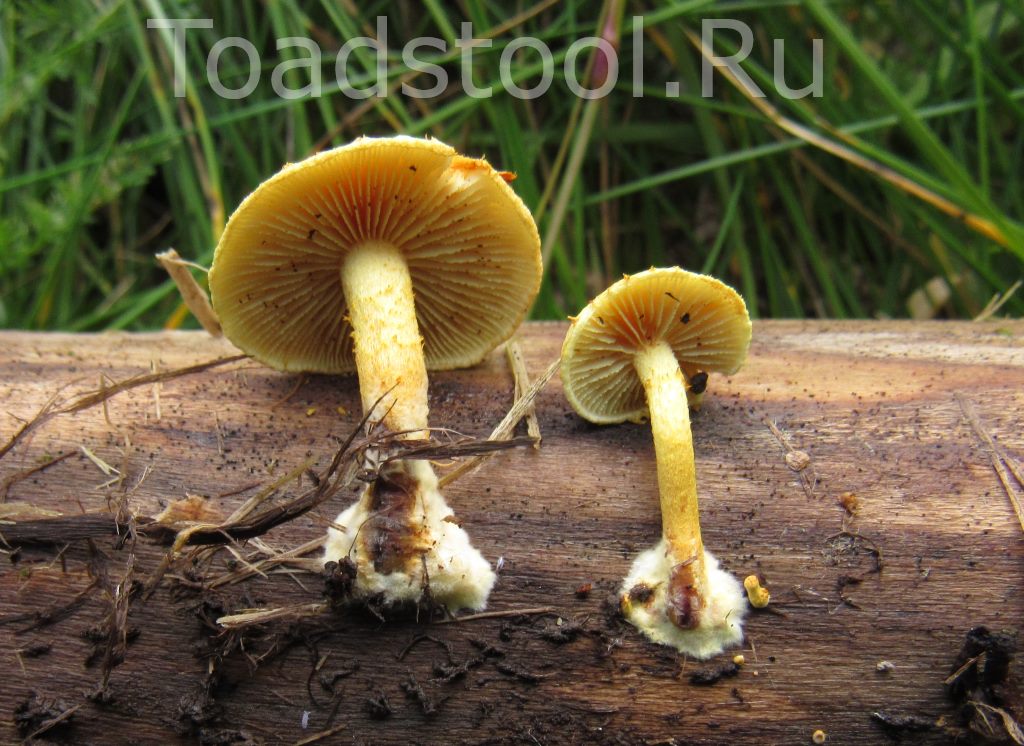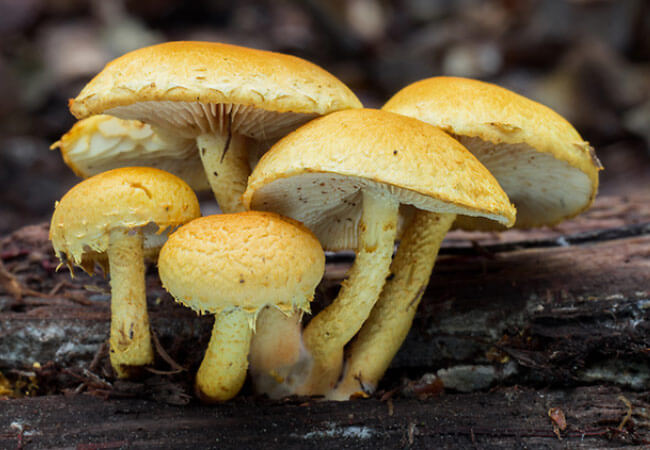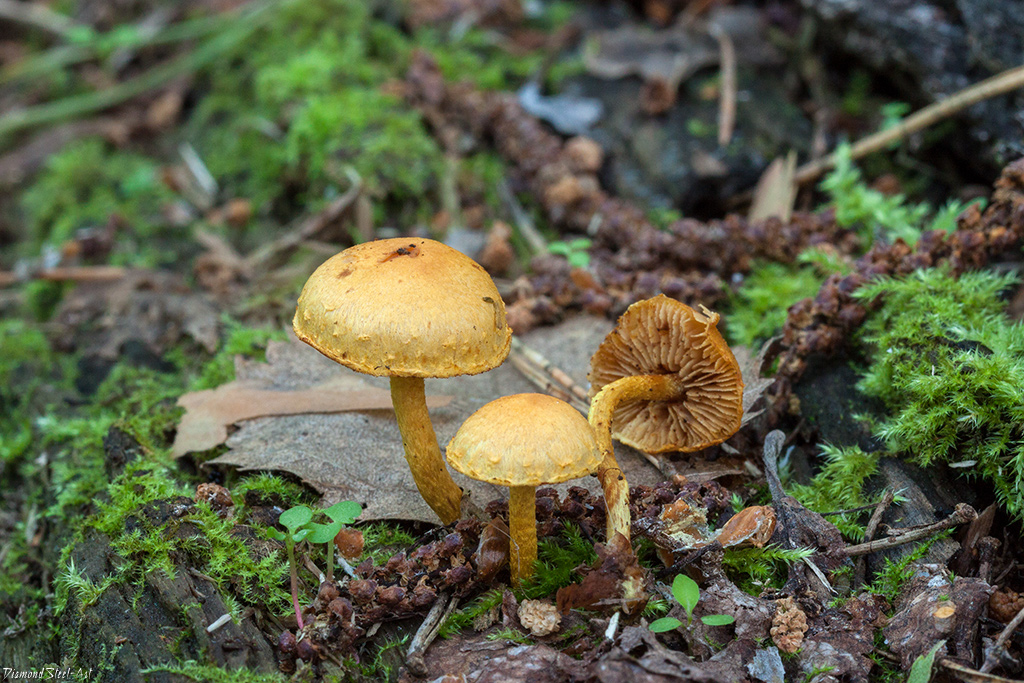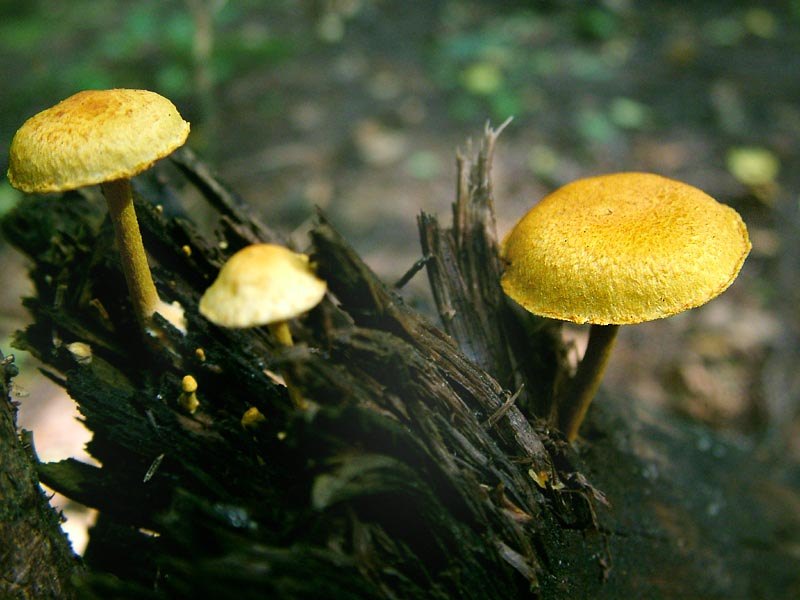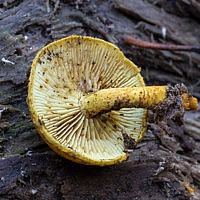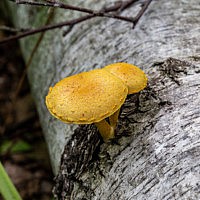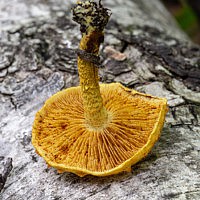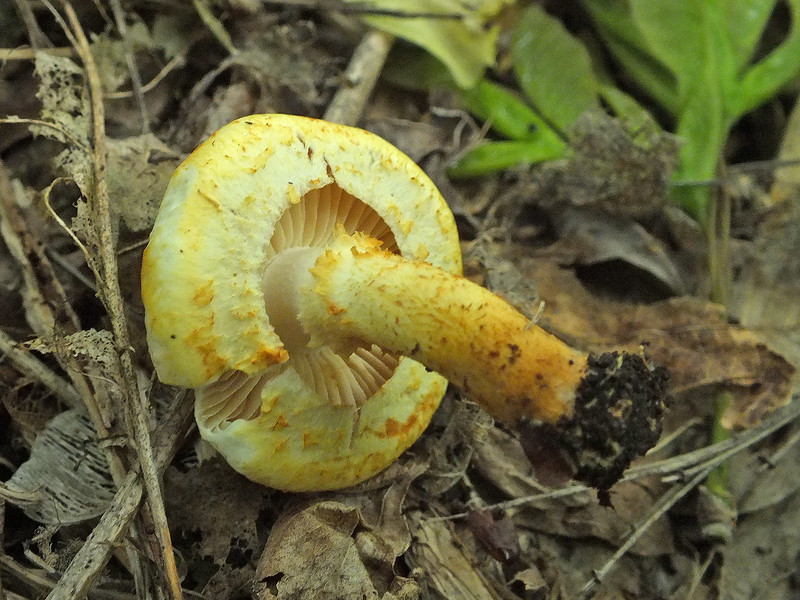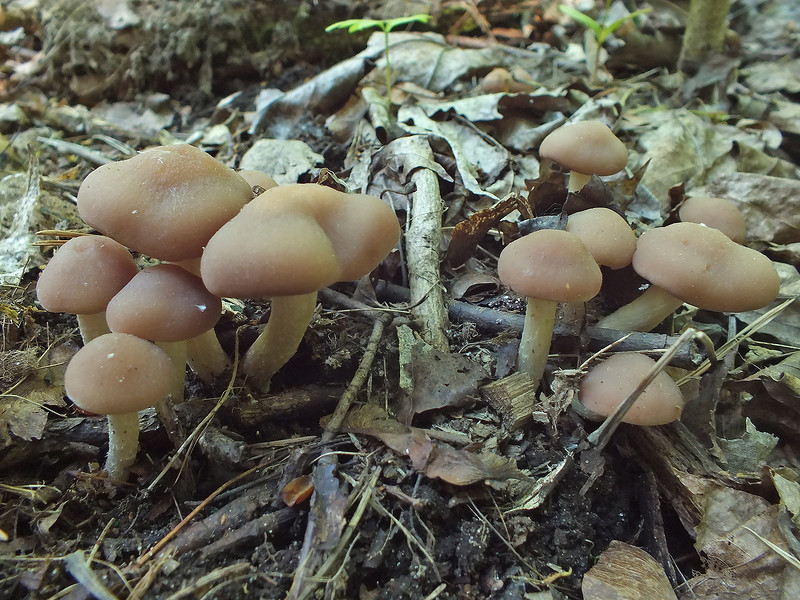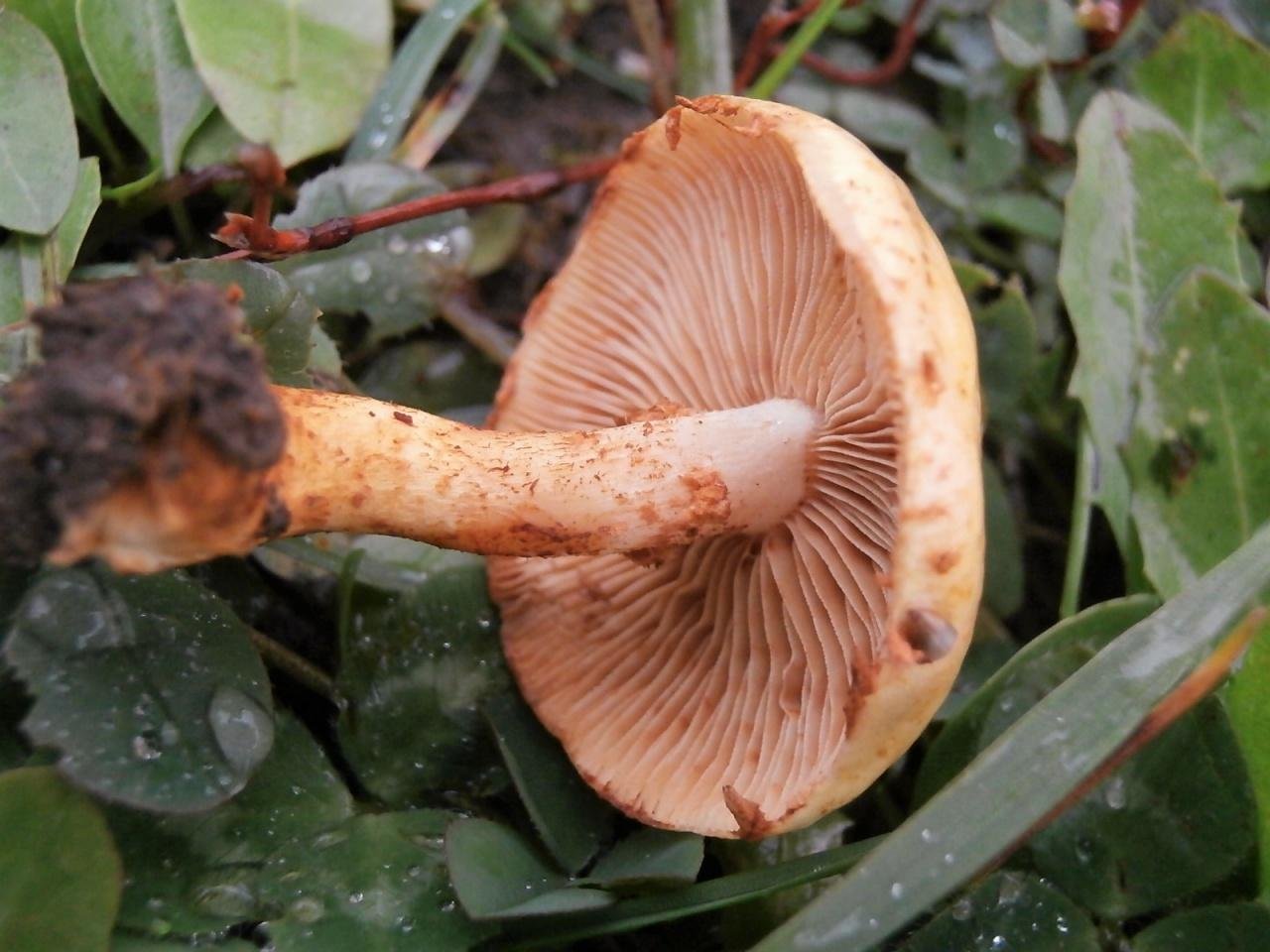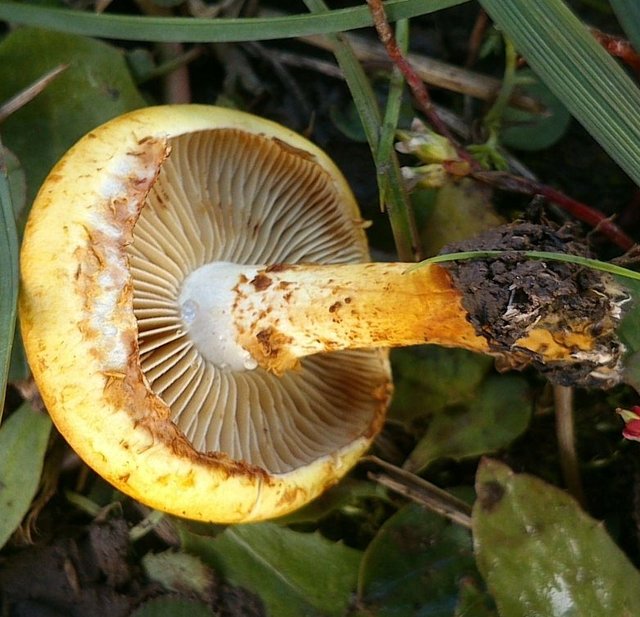Sticky scales (Pholiota lenta)
or
External description
Hat: in youth, the cap of the mushroom has a convex shape, then it becomes prostrate. In the central part there is often a blunt tubercle, accentuated by color. The surface of the cap is whitish in young mushrooms, then the cap acquires a clay-yellow color. The tubercle in the central part of the cap has a darker shade. The surface of the cap is very slimy, even in dry weather. The cap is covered with tightly pressed, often inconspicuous scales. Scraps of the bedspread are often visible along the slightly tucked edges of the cap. In rainy, humid weather, the surface of the cap becomes slimy.
Flesh: The bonnet is characterized by a watery flesh of a light cream color. The pulp has an expressionless mushroom smell and practically no taste.
Plates: adherent, frequent plates in young mushrooms of a light clay color, in mature mushrooms, under the influence of ripened spores, the plates become rusty-brown. In his youth, the plate is hidden by a cobweb veil.
Spore powder: brown.
Leg: cylindrical leg, up to 8 cm high. No more than 0.8 cm thick. The leg is often curved, which is due to the growing conditions of the mushroom. Inside, the leg is made or solid. In the center of the cap there are remnants of the bedspread, which visually divide the leg into two areas. In the upper part, the leg is light creamy, smooth. In the lower part, the leg is covered with large flaky white scales. The flesh of the leg is more fibrous and tough. At the base, the flesh is reddish-brown, slightly lighter above, closer to yellowish color.
Spreading
Glutinous scales are considered a late fungus. The fruiting period begins in autumn and ends with the first frost in November. It is found in mixed and coniferous forests, on the remains of spruces and pines. It is also found on the soil near the stumps. Grows in small groups.
Similarity
The uniqueness of the fungus Scaly sticky is late fruiting and a very slimy, sticky cap. But, nevertheless, there is one species similar to sticky scales, with the same slimy fruit bodies, and this species bears fruit just as late.
Edibility
Glutinous scales - an edible mushroom, but due to its slimy appearance, it is not appreciated in mushroom cooking. Although eyewitnesses claim that this is just a disguise and the mushroom is not only edible, but also quite tasty.
Video about the mushroom Scaly sticky:
Note: It should be noted that not every slimy mushroom looks untidy and repulsive. Despite its obvious stickiness, Pholiota lenta is neat and pretty enough.
Scaly mucosa: photo and description
| Name: | Scaly mucosa |
| Latin name: | Pholiota lubrica |
| Type of: | Conditionally edible |
| Specifications: |
|
| Systematics: |
|
The fungus of the stropharia family of flakes is distributed throughout the country. There are many varieties of it: slimy scaly, fiery, golden and other types.
Mushrooms are considered conditionally edible, have beneficial properties used for treatment in traditional medicine. They grow in small families on stumps, roots and in the hollows of trees (most often birches and willows).
What does scaly mucosa look like?
Externally, the scaly mucosa is similar to honey agarics, it grows in the same groups. The avid mushroom pickers of our country most often neglect this species, mistaking it for a toadstool.
In eastern countries, flake is very popular, occupies a worthy place in cooking, and is grown in artificially created conditions.
This mushroom is also called mucous champignon, flamulla, fiberglass and greenlandic scaly.
Description of the hat
In young specimens of flamulla, the mucous cap is bell-shaped with a closed edge. With growth, the cap becomes slightly concave and unfolded, reaching 50 - 100 mm in size.
The color of the cap is brown, more saturated in the center. It is covered with a matte skin, abundantly covered with scales. In damp weather, the skin becomes sticky. At the edges of the cap, you can find the remains of the blanket, washed away by the rain during the growth.
As it grows, the hat bottom is covered with weak yellow-green plates, occasionally covered with brown spots.
Leg description
The cylindrical hollow leg of a young mushroom is usually crooked, has a height of up to 10 cm, and its diameter is no more than 10 mm. As it grows, the cavity of the leg is filled with cotton pulp.
There is a yellowish ring on the leg of a young scale, which quickly disappears. The edges of the ring are red in color, and under the ring itself there are many scales.
Is the mushroom edible or not
The mucous fiber is a conditionally edible mushroom. All parts of young specimens and caps of adult mushrooms are suitable for food. During processing, the legs become very hard and tasteless, and therefore are not used in cooking.
Despite the fact that mucous flakes lack a strong mushroom aroma, they are suitable for cooking main courses and pickling. Gourmets refer to the type of flakes as a delicacy. Before the main stages of cooking, the mushrooms must be boiled for a quarter of an hour. Drain the water. This is how they get rid of the inherent bitterness.
The healing properties of mucous scales
Currently, the types of fungi of scale are not fully understood. Scientific studies carried out in laboratory conditions on white mice have shown that in the fibrous mucosa there are substances that can stop the growth of tumor cells.
Where and how it grows
The localization and method of growth of this type of mushroom is similar to the mushrooms, which are widely known to avid mushroom pickers. Scaly scales grow on rotten, rotten wood. It settles in small families, prefers coniferous and mixed forests with a temperate climate.
In Russia, it is widespread in Karelia, in the Far East, in the forests of the Urals and Siberia. Fruiting begins in late August and lasts until the first frost.
Doubles and their differences
Due to the fact that flake is little known among mushroom pickers, it is often confused with other types:
- Honey mushrooms. In contrast to the fiberglass, honey agarics have a denser ring of the leg and the plate of the cap. The color is also excellent. Honey mushrooms are considered conditionally edible and are widely used in cooking;
- Blue-bore spiderwebs (staining) are an inedible type of mushroom that grows on mosses in swampy areas. Cobwebs have a different color from flamull: ocher with a bluish tint or violet-blue color.
Conclusion
Despite the fact that slimy scales are little known, and few fans of mushroom hunting pay due attention to it, the mushroom has some advantages. With proper culinary processing, delicious dishes and blanks are obtained from it.
The medicinal properties suggest that eating and as a medicinal raw material can benefit the body.
Description of destructive scales
The diameter of the cap of this mushroom is 5-20 centimeters. The shape of the cap is convex-rounded. The color of the cap is light brown or yellowish white. The cap is studded with wide fibrous white scales. When the mushroom matures, the scales completely disappear. The edge of the cap is sinuous, fibrous.
The flesh of the mushroom is white, and yellow-brown at the base. The plates of young mushrooms are white, and with age they turn dark brown. The plates are often located, they are adherent to the leg.
The leg of the destructive flake is 5-15 centimeters, its diameter is 2-3 centimeters. To the top, the leg is refined, to the base it is swollen.The color of the leg matches the cap. Its surface is covered with large flaky white scales. Subsequently, the scales disappear. There is a white ring on the leg, which disappears over time.

Places of growth of destructive scales
Destructive scales settle on dying deciduous trees and stumps. These mushrooms are chosen by aspen, willow, birch, poplar. They grow in groups. Fruiting time is August-November. Destructive flakes are widespread in the European part of Russia, Primorsky Territory, Siberia.
Evaluation of destructive flakes
Destructive scales are inedible. Its smell is unpleasant, the taste of young mushrooms is bitter, and by the time of ripening it becomes sweet.

Related species
Scale golden or willow is an edible mushroom. The diameter of its cap can reach 18 centimeters. The shape of the cap varies from broadly bell-shaped to flat-round. The color of the cap is rusty yellow. There are flaky reddish scales over the entire surface of the cap. The pulp is white-yellow in color. The length of the leg reaches 10 centimeters, with a diameter of about 1.5 centimeters. The color of the leg is yellow-brown with rusty-brown scales.
Golden scales grow in large groups. These mushrooms settle directly on the trunks of deciduous trees or next to them. The fruiting period is August-September. They are common throughout our country.

Cinder scale is an inedible mushroom. The shape of young mushrooms is similar to a hemisphere, but over time it opens, but not completely. Its diameter reaches 6 centimeters. Often the surface of the cap is slimy. The pulp is dense and thick, light yellow in color, without any special taste or smell. The leg is fibrous, up to 6 centimeters long, the trace from the ring on it is practically invisible. Its surface is dotted with reddish brown scales.
Cinder flakes have been found since May and bear fruit until October. These mushrooms grow on charred wood and in the places of old fires. There is no information about their edibility.

Scale golden
Scale golden - lat.Pholiota aurivella
In another way, it is called Tsiermo, Golden yellow scales, Royal honeycomb, Sulfur yellow scales, Ivnyak, Feiliner, Thick scales, Huangsan, Sebaceous scales or Lyumo.
Description
Mushroom cap
Ivnyak has large hats with a diameter of 50-180 mm. Young mushrooms are born with small caps in the form of wide bells; older specimens have tight, flat-round "headdresses".
The surface of the hat is covered with reddish scales in the form of flakes, which makes it appear disheveled. The skin is colored in yellow - red or dark - golden tone.
The bottom of the hats is decorated with wide accreting plates, which at first have a pale straw color, becoming brownish or olive-brown by old age.
The hats are filled with dense, pale yellow flesh.
Thick scales reproduce by buffy spores.
Stipe
The legs of the scales are very dense and reach 10-15 mm in thickness and 70-100 mm in length. They are brownish-yellow in color and covered with reddish-brown flakes.
In adolescence, the trunk is decorated with a fibrous ringlet, in adulthood it disappears.
Places of growth and fruiting
Scale golden yellow grows well in a deciduous forest on the trunks and wood remains of alder and willow, less often birch trees. It is sometimes found in conifers growing in wetlands. The mushroom is easily found on the Australian continent and the Japanese islands, in Russia, China and European countries.
Willow, like mushrooms, bears fruit in small families. Mushrooms are born in the second half of July, fruiting ends in mid-October.
Edibility
Golden flakes are prepared for consumption only after a 20-minute preliminary boiling. Its pulp has a pleasant taste and is suitable for preparing main courses and salads. Mushrooms are delicious when paired with fried potatoes.
The flakes are not only boiled, stewed and fried, but also salted and pickled, for which mushrooms collected in conifers are more suitable and have a more tart taste. And mushrooms from deciduous forests are best dried or frozen for subsequent cooking.
Scale golden - lat.Pholiota aurivella
- Fiery scales. Differs in bright yellow color with lemon scales and yellow - orange pulp. Mushrooms growing in spruce forests have a bitter taste.
- Scaly scales. It has a lighter color and small caps with a sticky surface.
- Autumn honey agaric. Differs in small scales.
Description of the mushroom
Scaly scales (Pholiota lenta) is a representative of the genus Scaly scales (Pholiota) of the Strophariaceae family. The species belongs to lamellar mushrooms. Other names: Clayy-yellow scales, Sticky foliota, Late fire, Snotty, Sticky lusk.
Hat
In young specimens, the cap is white or light yellow, convex, hemispherical in shape. Over time, it becomes widespread and acquires a more intense clay-yellow color, reaching a size of 3–8 cm. There is a rounded dark tubercle in the central part. The surface of the cap, even in dry weather, is covered with a layer of mucus, which becomes more pronounced on rainy days.
The scales on the fruiting body are tightly pressed. In young mushrooms, they are most noticeable, flaky.
Hymenophore
The lower part of the cap in mushrooms is a hymenophore, which is necessary for the formation of spores.
You should definitely pay attention to this sign. In scales, a sticky hymenophore is lamellar, closely adhered to the pulp of the cap
In young mushrooms, the plates are light in color. As the spores mature, they darken and become brownish.

Cut pulp
On the cut, the flesh of the cap is watery, has a light creamy color. The smell is expressionless mushroom. The pulp of the leg is fibrous, hard and watery, ocher-brown at the base, light, yellowish towards the top.
Leg
The leg of the adhesive scale is straight, cylindrical, without a cavity inside. May bend slightly if an obstacle is in the way of growth. The leg reaches 4–8 cm in height and 0.3–0.8 cm in thickness. In young mushrooms, the remains of the bedspread form a small ring, visually dividing the stem into 2 parts:
- upper: smooth, light cream, uniform;
- lower: dark, rusty-brown at the base, thickened, covered with tomentose flaky scales.
As the fungus ages, the ring disappears, but the leg heterogeneity remains.
A bit of history
For the first time, sticky flake was described at the end of the 18th century. The work belongs to Christian Heinrich Person, a Dutch botanist-mycologist who compiled the first scientific system of mushrooms.
Poisonous and inedible species of fungus scaly
Carbon-loving flake (Pholiota highlandensis)
Inedible mushroom.
The diameter of the cap is 2-6 cm, the shape is convex, then convex-prostrate. The skin is orange-brown or ocher-brown with a light edge, the surface is sticky, shiny, scaly. The pulp is thin, yellowish-brown in color, the taste and smell are not expressed. The leg is 3-6 cm in height, 0.4-0.8 cm in diameter, cylindrical, thickens towards the base. Above it is yellowish, below it is dark brown, scaly.
Distributed in the northern temperate zone, growing in groups from June to early winter.
Fire scales (Pholiota flammans)
Inedible mushroom.
The diameter of the cap is 2.5-7 cm, the shape is hemispherical or conical in a young mushroom, with age it becomes convex and plano-convex, the edge is bent. The surface is covered with dry bright yellow scales, slimy, yellow-orange in color. The pulp is yellow-orange, brownish in the stem, has an earthy odor, the taste is insipid or bitter. The leg is 3-7 cm high, up to 1 cm thick, in mature mushrooms it is hollow, with a ring, below the ring it is covered with bright yellow scales.
The species is widespread in Eurasia; it grows on the dead wood of coniferous trees.
Application in traditional medicine
Medicines (decoctions, infusions, tinctures) are prepared from foliot, which are used by traditional healers in the treatment of diseases of the cardiovascular system (atherosclerosis, arterial hypertension, varicose veins, thrombophlebitis).Iron and magnesium foliot contribute to an increase in hemoglobin levels, so the introduction of these mushrooms into the diet will be beneficial for anemia and thyroid diseases.
Due to the large amount of fiber in the pulp, royal mushrooms prevent constipation. The presence of squarrosidine in the pulp of royal honey agaric makes them an indispensable food for people suffering from gout. Means from the fire in folk medicine are used as an emetic and laxative.
Due to their low calorie content, royal mushrooms are included in the diet of diabetics, vegetarians and people on a diet. It is scientifically proven that the extract of fresh golden foliot inhibits the growth of Ehrlich's carcinoma and sarcoma-180 in laboratory mice.
Taste qualities and recipes
Glutinous scales are edible mushroom of the 4th category. The leg is watery and not eaten. The mucous skin is easily separated from the pulp of the fruiting body, but to remove the mucus, it is enough to rinse the mushroom under cold water. Before further use, the caps should be welded for 15 minutes.
Glutinous scales are used in second courses, salted and pickled. To do this, use classic recipes.
Pickling
Ingredients for 1 liter of water:
- 2 kg of mushrooms;
- 2 tsp salt;
- 1 tbsp. l. Sahara;
- 1.5 tsp vinegar;
- Bay leaf;
- Carnation;
- black peppercorns.
Preparation:
- For the marinade, boil 1 liter of water with salt, sugar, vinegar and spices.
- Sort the washed mushrooms by size, large ones - cut into slices.
- Soak in salted cold water for 1 hour, drain in a colander.
- Pour in fresh water, bring to a boil and drain the broth.
- Repeat the procedure (p. 4), but cook for 15 minutes, removing the foam.
- Drain the broth, put the mushrooms in prepared jars, pour the marinade and roll up.
Salting
Ingredients:
- 1.5 kg of flakes;
- 70 g salt;
- Bay leaf;
- Carnation;
- black peppercorns;
- currant and cherry leaves;
- dill umbrellas.
Salting recipe:
- Boil the washed mushrooms for 20 minutes. with the addition of salt, bay leaves, cloves and black peppercorns.
- Drain the broth, spread the flakes in a prepared dish in layers, sprinkle with salt and pepper and shift with currant and cherry leaves, dill umbrellas (if possible).
- Cover the top with gauze folded in several layers and press down with a load.





